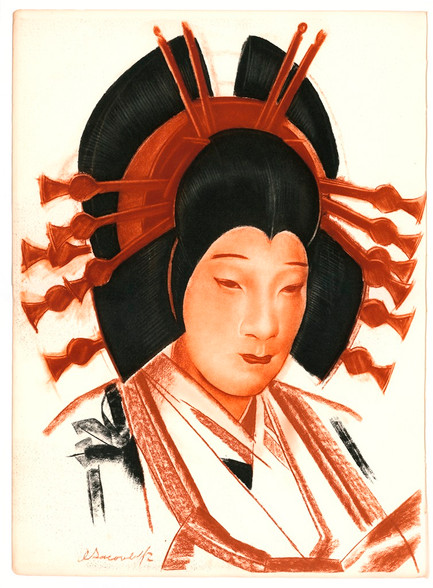 Loading... Please wait...
Loading... Please wait...All prices are in All prices are in USD
Categories
- Home
- Giclee Prints
- Giclee Art Deco Kabuki Theater Iacovleff Japanese Courtesan
- Home
- Giclee Prints
- Kabuki Theater- Art Deco
- Giclee Art Deco Kabuki Theater Iacovleff Japanese Courtesan
Product Description
Theater, Kabuki, Japan, Alexandre Iacovleff, Le Theatre Japonais, Courtesan, Kanzashi, Kimono, Aleksandr Yakovlev, Art Deco, Japan, 1936
Plate 31) In the role of a courtesan, we are shown the traditional hair pin decoration, Kanzashi, that compliments and overlays the neckline of the Kimono.
Archival Limited Edition Giclee print after the original heliogravure by Russian artist Alexander Evgenievich Iacovleff for Kabuki Japonais, published in 1838, the year of his death.
Print Size = 28 x 38 cm / 11 1/6 x 15 1/6 inches
Issued with Archival Limited Edition Certificate
Role of Courtesans
In the Japanese Edo period courtesans were far more than prostitutes. Courtesans had to be accomplished dancers, musicians, master the art of conversation among many other entertainments that could only be performed within the licensed quarters. Only very wealthy men could afford an appointment with the top courtesans. It is said that the very tradition of Kabuki began with a highly skilled courtesan circa 1600. It is ironical that women can not perform female roles in Kabuki. Actors who play female roles are called onnagata. Although there are some who act both male and female characters with great skill (kaneru yakusha), there are many important roles that call for true specialists.
Kanzashi: Style of Japanese Hair Ornamentation
Kanzashi is the term used for a traditional Japanese hairstyle for women. In the middle and the late of Edo period (1700-1800), the way of doing hair that was intricately developed when hairstyles became larger and more complicated, using a larger number of ornaments. Artisans began to produce more finely crafted products, including some hair ornaments that could be used as defensive weapons. During the latter part of the Edo period, the craftsmanship of Kanzashi reached a high point, with many styles and designs being created.









